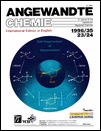Te6, [Te8Cl18]2−, and [TeCl3]−: New Tellurium and Chlorotellurato Ligands in the Re6 Solid-State Cluster Compounds Re6Te16Cl18 and Re6Te16Cl6†‡
This research was sponsored by the U. S. National Science Foundation, Grant DMR91-14934.
Dedicated to Professor Richard H. Holm
Graphical Abstract
Re6 octahedra inside Te8 cubes is a common feature of both title compounds. The picture on the right shows a section of the structure of Re6Te16Cl18, in which the Re6 octahedron and the binding of the cluster to the [Te8Cl18]2− ligand are apparent. Different binding to ligands results in a three-dimensional structure for Re6Te16Cl18, and a two-dimensional structure for Re6Te16Cl6.





